Crafting the Intersection Between Indoors and Outdoors
An in-depth look at multi-panel door systems
![]() Continuing Education
Continuing Education
Use the following learning objectives to focus your study while reading this month’s Continuing Education article.
Learning Objectives - After reading this article, you will be able to:
- Examine the types of multi-panel systems available and their most appropriate applications, both aesthetically and from an energy performance standpoint.
- Describe the range of material and threshold options, and their critical energy performance and sustainability impacts on the building envelope.
- Identify the key specifying considerations for multi-panel door systems.
- Discuss essential manufacturing core competencies when considering multi panel systems providers, including necessary energy performance testing, sustainability considerations, and certifications.
An architect puts pen to paper, dreaming up an initial sketch that melds a building seamlessly with its environment, complementing topography, and surroundings. The ability to bring the outdoors in, and for a building to reflect its surroundings, is a hallmark of modern design. Outdoor rooms that flow naturally into interior spaces not only enhance a structure’s footprint, they also provide ventilation, fresh air, and daylight, and connect occupants to nature.
Facilitating the fusion between the interior and the outside is the job of multi-panel door systems. A multi-panel door system is a door or window system with multiple operable panels that open sequentially to create a large opening. Reaching beyond the capability of a traditional hinged door, multi-panel systems don’t just transition between indoors and out. Instead, the wide and seamless opening they furnish blends nature into a room or series of rooms, eliminating the perceived divide.
Not only do multi-panel door systems improve important health metrics, like indoor air quality, as enhancements in manufacturing and technology have augmented door efficiency, these systems can occupy a greater area in the building envelope without compromising overall performance.

Photo courtesy of Build LLC
Multi-panel door systems eliminate barriers between interior and exterior spaces, creating a natural and open flow. Aluminum thermally broken folding doors showcase the beauty of surrounding landscaping at this home.
Meet the Family: An Introduction to Types of Multi-Panel Door Systems
Multi-panel door systems are, as the name describes, composed of multiple panels. The ways in which these panels operate defines the type of system. The most common types of multi-panel door systems are folding and multi-slide. Multi-slide doors may be further separated into stacking multi-slide or pocketing multi-slide.
Multi-Slide Doors
In a multi-slide door, panels stack within the opening.
Multi-slide glass doors are generally used to create large openings in walls or to take the place of an exterior wall altogether. The size of the panels and the total door unit can vary and may be custom fabricated to suit a particular building project. Usually, it is the glass itself that imposes limits on the size of each individual multi-slide panel. Most single pieces of glass are limited to 60 square feet in size, with a typical maximum height of 12 feet and a width of 8 feet. The number of individual panels can be varied to meet the desired opening dimensions.
The configuration of multi-slide door panels can be designed so that all panels stack behind each other on one side of the opening, or so that panels are split to stack on both sides of the opening. There are two basic options for how the individual panels appear when stacked. The first option is to keep one glass panel fixed, or stationary, and to slide all adjacent panels to stack evenly behind this stationary panel. In using this option, when fully stacked, some manufactured designs appear as a single panel when viewed from the inside or outside. The second option is to conceal the sliding panels in a wall pocket when open. In this style, the sliding panels disappear altogether, giving the appearance of a full opening in an otherwise solid wall area.
Multi-slide doors do not need to be limited to a single wall plane. Manufacturers have developed methods to allow doors to meet at a corner location, eliminating the need for a post or frame element. When open, the corner virtually disappears, allowing a full visual and physical three-dimensional connection between outdoors and inside. When fully closed, the door panels come together to form the corner.
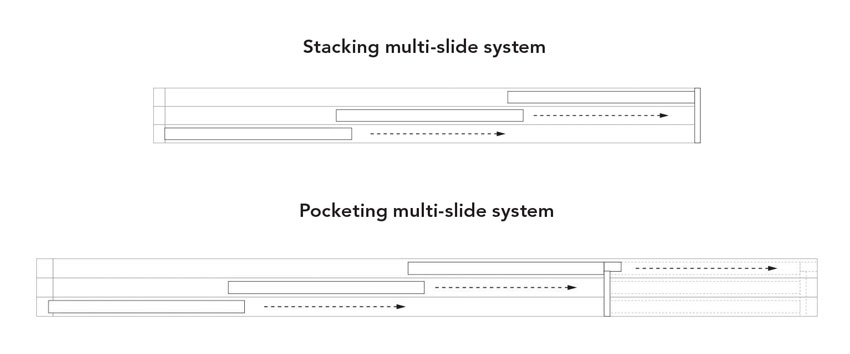
Image courtesy of LaCantina Doors
Multi-slide doors are classified by their different operation methods: stacking multi-slide doors and pocketing multi-slide doors.
Folding Doors
In a folding multi-panel door system, panels stack perpendicular to the opening when fully opened. As with multi-slide systems, in folding systems, doors may stack to one side when open, or can divide and stack to both sides of the opening. The folding action mimics the expansion and contraction of an accordion. The panels may be inswing or outswing, depending on design preference and use. Because of the weight of the system, individual folding door panels are typically limited to 39 inches in width; standard heights may be 7 to 8 feet tall or can be made to measure up to 10 feet tall. Despite those limitations, openings for a full system of folding doors can reach up to a staggering 65 feet wide.
Folding glass doors may either be floor-mounted or top-hung, with top-hung systems the predominant method. In a top hung folding door system, the top track carries the weight of the doors and the floor track serves as a guide. Precision bearings and rolling hardware are used to operate the door. Top-hung systems allow for effortless and smoother operation and longer lifespans. The frame must be secured to an adequate header that does not deflect downward when the doors are installed. The structural support required and header size depends both on the weight of the doors and the surrounding structural conditions.
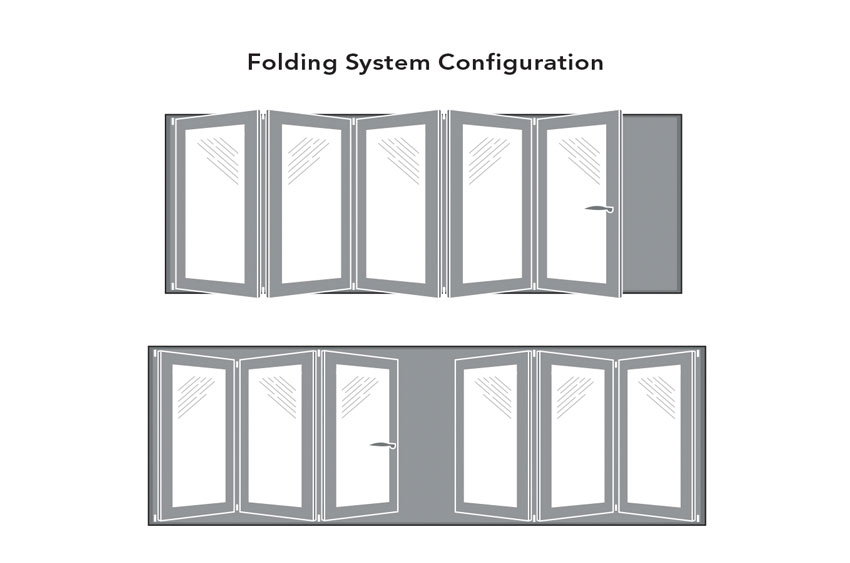
Image courtesy of LaCantina Doors
Daily access door on any configuration that includes an odd number of panels.
Bringing More Green To Your Buildings: Sustainability and Environmental Benefits
Multi-panel door systems not only open up design opportunities by erasing the border between inside and out, they also enhance the sustainability of a structure. The benefits of a multi-panel system are not confined just to their operation–a thoughtfully selected product has environmental advantages inherent in the very materials it uses.
Natural Daylighting: Allowing for more glass and light, multi-panel door systems can be a good passive heat source and minimize use of electricity for daytime lighting.
Energy Efficient: Most multi-panel door systems offer dual-paned tempered glass, creating an insulating barrier between the inside and out. Manufacturers may offer advanced low-e glass options to help reduce cooling costs in the summer and heating costs in the winter. Overall U-factors (insulating factors) in the door panels can be achieved at or near the common fenestration target of 0.30 or better depending on specific glazing selections made for low-e or other coatings. While no piece of fenestration can match the insulating performance of a wall, having the highest-performing glass and door systems installed in designated openings supports the overall performance goals of the project.
Fresh-Air Ventilation: A critical aspect of green design evaluates the indoor air quality for healthy living environments. Indoor air quality (IAQ) refers to the air quality within and around buildings and structures, especially as it relates to the health and comfort of building occupants. Common pollutants can occur and build up indoors, creating the risk of indoor health concerns. Using multi-panel systems opens up areas typically blocked by walls and aids in whole house air circulation, bringing clean and fresh air into any structure and replacing existing, stale air.
Local Manufacturing: Finding a domestic or local manufacturer contributes to green design by minimizing fuel and transportation costs normally associated by importing products from areas outside of the United States.
Recycled Packaging and Materials: Certain manufacturers pack and ship systems using recycled materials, providing safe transport and smart use of renewable resources.
LEED Projects: Multi-panel door systems can help to earn a LEED designation for projects. Architects and project owners can submit many of these characteristics for point consideration within their project. Please note that as LEED v4 becomes fully enforced, points may be categorized differently.
Possible LEED v3 points opportunities:
• Energy & Atmosphere Prerequisite 2
• Energy & Atmosphere Credit 1
• Materials & Resources credit 2
• Indoor Environment Quality Credit 4.4
• Indoor Environment Quality 6.2
• Indoor Environment Quality 8.1
• Indoor Environment Quality 8.2
Responsible Materials: If wood or clad multi-panel door systems are under consideration, certain manufacturers offer FSC-certified wood. The Forest Stewardship Council (FSC) sets forth principles, criteria, and standards to guide forest management and practices toward sustainable forestry worldwide. FSC certifiers verify that companies claiming to sell FSC-certified products have tracked their supply back to FSC-certified sources. This chain of custody certification assures that consumers can trust the FSC label.
NFRC, the Meanting of Green, and Mutli-Panel Door Systems
Classifying and labeling the real thermal performance of door and window systems is the focus of The National Fenestration Rating Council (NFRC), a not-for-profit trade association. In 1993, NFRC developed the first consensus method for evaluating the thermal transmission of windows. Today, NFRC 100: Procedures for Determining Fenestration Product U-factors is the accepted standard for rating windows, doors, and skylights for U-factor. A U-factor is typically rated between 0.20 and 1.20. This standard establishes standardized environmental conditions, product sizes, and testing requirements, so that architects and others can make informed choices fairly and accurately by comparing the performance of different products.
One of the most important improvements that NFRC 100 offered the industry was a determination of heat loss from the entire window unit, rather than heat loss solely from the glass. Under this all-encompassing evaluation, a multi-panel door system earns credit for all of its energy-efficient features, including energy-efficient glass, thermally improved frames, and even down to such minutiae as the spacers used between layers of insulated glass.
NFRC testing also looks at other overall performance characteristics, including the solar heat gain coefficient (SHGC), which measures how much solar energy passes through a particular glazing, creating heat gains inside a building. A SHGC is expressed as a number between 0 and 1. In areas where heat gains are a concern, coatings are applied to the glass to allow less transference.
NFRC testing also responds to green building standards by assigning a value to the visible light transmittance (VT). Values are between 0 and 1. VT determines the effective light available for daylighting, helping gauge potential offset of electricity costs for lighting a building’s interiors.
In addition to thermal performance, codes, and standards, including those of the NFRC, have increasingly recognized air leakage (AL) as a very significant factor in fenestration performance. Today’s window and door products must meet minimum standards for air infiltration and be tested, certified, and labeled for this performance. The total system must be able to withstand wind pressures associated with its geographic location, and air leakage must be controlled not only for energy performance but also for occupant comfort and long-term durability of the fenestration system. NFRC expresses AL as a number ranging between 0.1 and 0.3.
U-factor, SHGC, VT, and AL are all disclosed on an NFRC label for an individual product. The lower the U-factor, the better the insulation level of the unit, meaning less heat loss to the outside or, in cooling dominated climates, less heat gain from the outside. A low SHGC means more solar energy will be blocked, eliminating passive heat gain from outside into the building. The higher the VT, the more natural light is transmitted through a product. A higher AL means greater air infiltration over the life of the product.
Typical high-performance multi-panel doors have U-factors of 0.32 or less and SHGC of 0.30 or less, depending on climate zone. The most suitable AL rating for an energy efficient building will be at or near 0.1; VT is dependent upon climate zone and client preference.
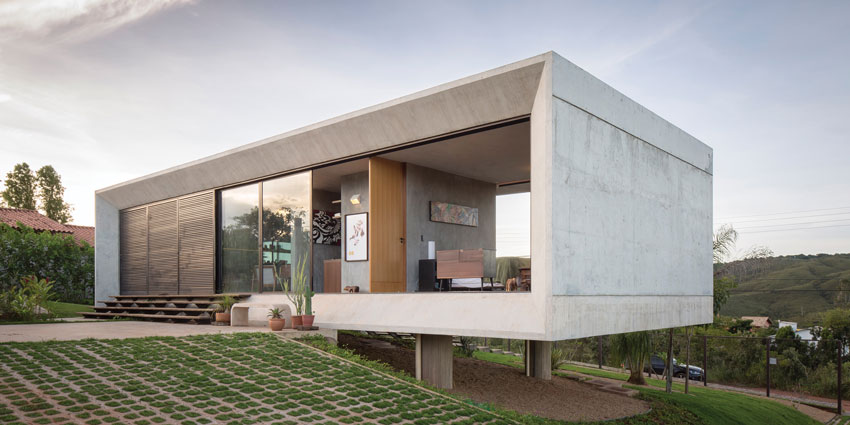
Photo courtesy of LaCantina Doors
Multi-panel door systems capture energy efficiency, natural daylighting, and boost indoor air quality. The multi-slide doors open this home dramatically to its environment.
The Natural Habitats of Multi-Panel Door Systems
The desire for commercial and residential clients alike to experience outdoor living environments and the unique flexibility of the product has resulted in multi-panel door systems being found in a wide variety of buildings.
Residential
Multi-panel door systems offer the ideal avenue to create an outdoor living experience for any home. By eliminating a wall or typical patio doors, these systems remove the distinction between the indoors and outdoors, creating a healthier, more comfortable environment with natural light and open air. Entertainment spaces flow naturally between the patio the living room or kitchen.
Restaurants and Retail Storefronts
Multi-panel door systems provide a unique opportunity for restaurant and retailers to attract customers and maximize valuable and costly commercial space. Whether creating a true al fresco dining experience or capturing a shopper’s attention through open-air marketing, multi-panel interior and exterior applications offer a dramatic design element.
Resort and Hospitality
Multi-panel door systems create large indoor/outdoor spaces that allow guests to enjoy gorgeous scenery and breathtaking sunsets with unobstructed views. The flexibility of these systems can accommodate guest rooms, suites and villas, outdoor cabanas, and high-rise balconies.
Additional Applications
Multi-panel door systems also can be found making better use of interior spaces or creating large open spaces by connecting the indoor and outdoor areas of schools, libraries, campuses, and museums. Form meets function with an interior or exterior application.
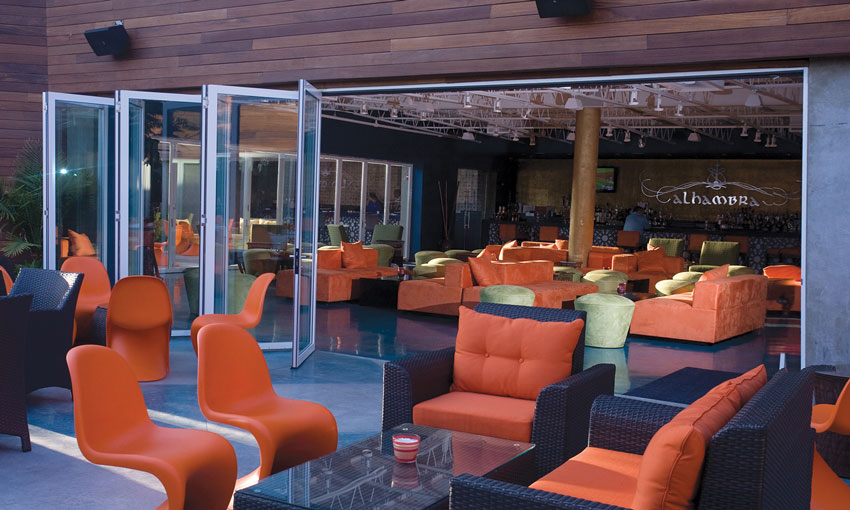
Photo courtesy of LaCantina Doors
Multi-panel door systems are a perfect compliment for commercial spaces, offering maximum use and an undivided flow from indoors, out. Aluminum folding system shown.
Specifying Considerations for Multi-Panel Systems: Material Type
Multi-panel door systems, both folding and multi-slide, are available in a variety of materials. Careful selection of each project’s door frame material should consider use, aesthetics, climate zone, and efficiency goals.
Aluminum
Aluminum systems have a clean, modern appeal, with some manufacturers offering a narrow 2¾ inch stile and rail profile, allowing for maximum glass and light. Aluminum is suitable for use in exterior applications or as interior space dividers. The basic configuration is an extruded aluminum panel wall thickness of up to ¼ inch, and single panels up to 10 feet tall. A 10-inch-tall bottom rail and low-rise sill meet commercial Americans with Disabilities Act (ADA) requirements. Aluminum panels are offered in several finish options. White paint, clear anodized, and dark bronze anodized aluminum rails and stiles match most commercial aluminum window finishes. Selecting aluminum eliminates the need for finishing and offers low maintenance. Aluminum typically has the highest U-factor and is best suited for use in moderate climates, where heat loss or gain is less of a concern.
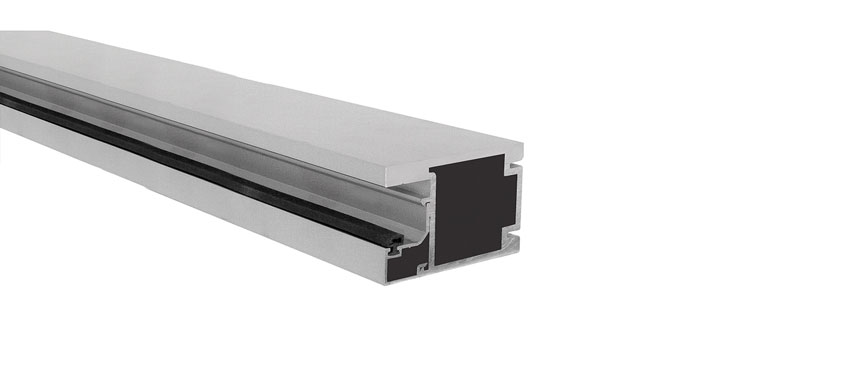
Photo courtesy of LaCantina Doors
Aluminum Thermally Controlled
This system offers improved thermal performance over traditional aluminum frames, suitable for climates where it is desirable to prevent extreme weather from impacting the conditioned interior space, and where higher resistance to water and air infiltration is required. Featuring non-conducting thermal breaks throughout and narrow stile and rail profiles, aluminum thermally controlled systems are designed for optimal energy efficiency and structural performance that minimizes condensation build-up and heat-cold transfer. European thermal struts create the non-conductive bridge between the outside and the inside of the door. Thicker panels (2¼ inches) are suitable for high-wind environments and can include impact-rated features. A proprietary panel design by a leading manufacturer allows for split finish color options for the interior and exterior of aluminum systems, providing maximum design flexibility.
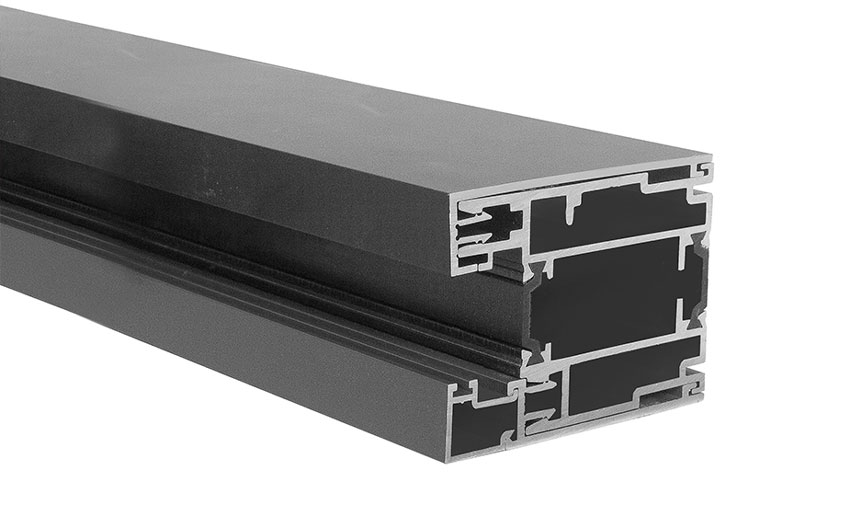
Photo courtesy of LaCantina Doors
Aluminum Wood
Better suited to exterior environments than a solid wood door, an aluminum wood system features a low-maintenance aluminum exterior with a natural wood interior. The hybrid panel construction typically consists of a 1¾-inch-thick extruded aluminum and ½-inch solid wood interior. Typically, several wood species options are offered, and commonly include vertical grain Douglas fir and mahogany. The exterior aluminum surface can be powder coated to a range of colors or finished for an all-wood look. An engineered aluminum panel construction creates strength and rigidity for panels more than 8 feet tall.
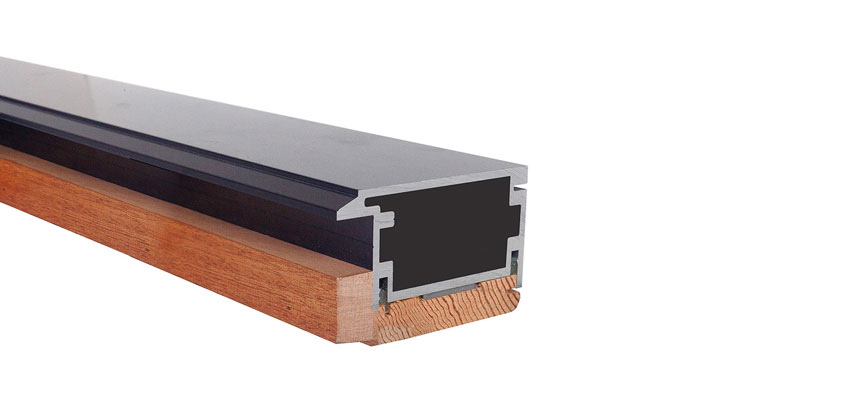
Photo courtesy of LaCantina Doors
Clad Systems
Made using heavy-gauge extruded aluminum on the exterior in combination with a solid laminated wood core construction and a natural wood interior facing, clad systems offer durability, efficiency, the beauty of wood, and the ability to withstand the elements. Clad systems typically complement more traditional architecture, and have the best overall U-factor of any frame material, offering maximum energy efficiency in colder climates. And the reach of clad systems is broadening. Certain manufacturers offer a newer, contemporary cladding system, which features consistent-width narrow stile and rails, square or sculpted profile designs, and standard anodized and painted finishes combined with the warmth of a wood interior. Contemporary clad suits a diversity of architectural styles and window packages.

Photo courtesy of LaCantina Doors
Wood
Best for interior space dividers or exterior applications shielded from weather, all wood systems lend a distinctive architectural style to a space. Usually available in a range of wood species, wood finishes are prepped by the factory for sealing, staining, or painting.
Standard wood systems incorporate a 35/8-inch stile and rail profile, with 7½-inch and 10-inch bottom rail options, and can accommodate custom panels from 1¾ inches to 2¼ inches thick. Most manufacturers use a solid laminated veneer lumber (LVL) wood core construction to maintain integrity of the frame. Wood can provide energy efficiency and good thermal performance, and, when FSC certified, earn the project green credits.
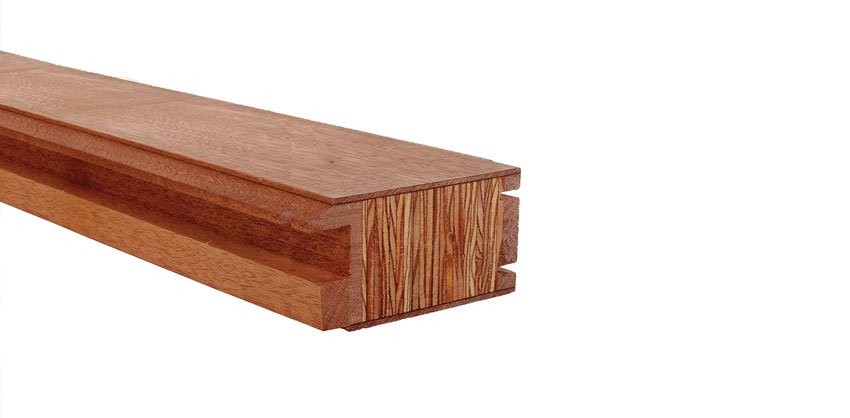
Photo courtesy of LaCantina Doors
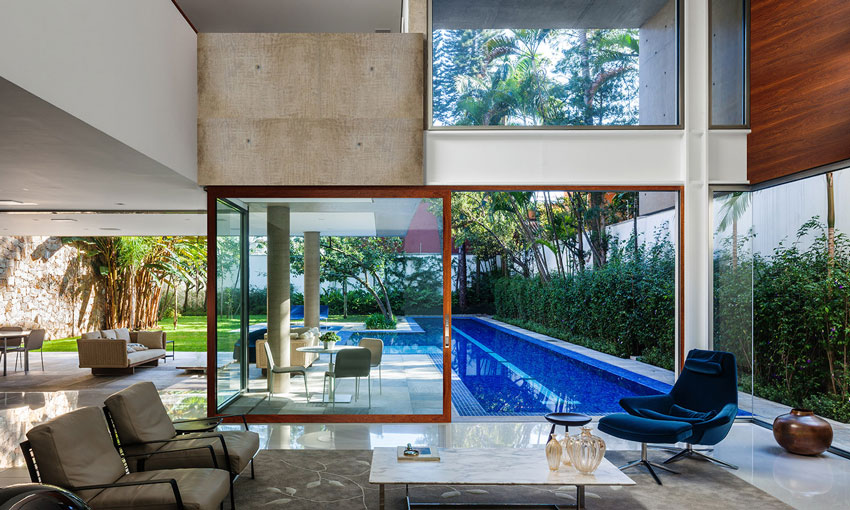
Photo courtesy of LaCantina Doors
The beauty of wood not only adds warmth but also offers energy efficiency. This contemporary clad multi-slide system offers a consistent width narrow stile and rail profile to compliment the style of the home.
Specifying Considerations for Multi-Panel Systems: Situation, System Type, and Configuration
When thinking about door selection, it is helpful to consider aesthetics, frequency of use, and impact probability. Doors selection is clearly a function of what fits the design of the space.
Multi-panel door systems marry well into a wide range of building types in a number of ways. They can be fully integrated with the building construction to create a seamless and flush appearance so that they seem to disappear altogether when open; in other cases, they can create a large feature in a facade by allowing for a distinctly defined opening. Multi-panel doors can be harnessed to further the overall building design and enhance or to define a particular aesthetic.
A vital balancing act during initial design, which will impact energy outcomes, is determining how much fenestration to use as a percentage of the overall wall area of a building. Many energy codes prefer to see total window and door space at or less than 40 percent of total wall space. Depending on exposure and climate zone, a large amount of glass on western- and south-facing walls can expose the building to unnecessary solar heat gain. However, using glass on a south-facing facade in a heating-dominant climate can yield passive solar heat gain during the winter when the sun is low in the sky, offsetting mechanical heating. Simple energy modeling of different scenarios during the earliest stages of design aids in selecting the most appropriate balance between walls, doors, and windows.
Visually, multi-panel door system sizes and proportions may be chosen to match the complement of single doors and windows in the building. Creating a unified design scheme for fenestration will help shape finish, operation, and profile options. Depending on the manufacturer, stile and rail sizes for multi-panel systems can be ordered to exactly match other doors in the facade. Once high-level energy and aesthetic concerns are addressed, examining the daily operation of the door helps dictate type and operation. High-traffic areas and openings subject to abuse require doors of heavy-duty construction. Frequency of use is classified as high, moderate, or low, depending on the door’s location in the building and the number of times per day the door will be used. For example, most building entrances are classified as high-frequency openings. Doors that normally remain in the open or closed positions are considered low-frequency openings. If a multi-panel door system will serve as the main entrance to a retail store or restaurant, and will be opened and closed throughout the day, with heavy foot traffic, a highly durable door frame, an easy-to-use hardware system, and a durable threshold need to be considered.
Impact probability also is classified as high, moderate, or low. Doors subject to high impact are often the very same doors with a high frequency of use, but not always. Referring to ANSI/SDI A250.8 may be helpful in guiding selection.
Multi-panel door systems are often selected with a design intent to embrace natural surroundings and exterior conditions. With this in mind, determine the optimal number of panels to maximize the amount of glass and natural daylighting. Individual sliding panels typically have a much wider maximum width than folding panels, meaning more glass and less frame disruption, whether the door is open or closed. However, folding systems are usually capable of spanning a greater width overall, a factor if the goal is to open up a maximum amount of wall space when the door system is in use.
Operational considerations involve studying the different types of door operations available and their swing or stack directions when designing a space. Key questions include how the space will be utilized, including furnishings and traffic flow, and determining the preferred location of door panels when fully open. Pinpointing where and how the system will be operated for daily use can also lend clues to preferred operation. If some drywall will feature on an elevation, a pocketing multi-slide door may be a great choice. A folding door might be best if the client wishes to use a multi-panel door in different configurations. When a homeowner requests a multi-panel door to open onto a small patio space, a multi-slide could be ideal, as it will avoid taking up valuable area whether open or closed.
Multi-panel door system type and configuration are ultimately a function of the design of home and space.
Specifying Considerations for Multi-Panel Systems: Thresholds and Components
It’s all in the details. Those pesky final steps in selecting a door, while often having minimal aesthetic impact, can still have important ramifications for the lifetime performance and efficiency of a multi-panel door system. Sills or thresholds need to be coordinated and should support both the door system and number of door panels. Thresholds should be selected based on weather exposure and floor transition.
Thresholds are available in at least three different profiles and should be specified according to the project design needs. Flush sills are designed to be recessed into the floor, creating a level transition between the finished interior floor surface and the exterior. Flush sills can incorporate the same finish flooring between the sill tracks. Flush sills offer seamless transitions and are a preferred solution for covered openings. Raised sills are intended to have a raised profile and sit up above the exterior. Depending on manufacturer, raised sills come in varying interior leg heights. Raised sills offer a greater degree of weather resistance. Raised sills, or special weather-resistant sills, are the preferred solution for weather-exposed openings.
Ramped sills are commercially compatible and offer ADA compliance when there is more than ½ inch change in the sill height compared to the walking surface. All threshold styles are typically thermally broken. The grade of material for the threshold should be specified, as well as the bearings, hinges, and wheels of the door panels. Nylon plastic and stainless steel are the most commonly seen materials. Stainless steel components usually offer the best durability and longevity for large or heavy door panels.

Photo courtesy of LaCantina Doors
Stacking multi-slide panels stack flush when fully opened. Aluminum wood multi-slide system shown with flush sill.
To control air leakage and improve energy efficiency, multi-panel door systems also rely on a mix of perimeter seals applied to each door panel. Top seals can be brush type to allow for the smooth operation of the door while still restricting the transfer of air and weather. The bottom or sill seal may be composed of low-friction coated rubber applied to the bottom of the door, creating a full seal yet allowing for the smooth operation of the door panels. Continuous seals along the edges of each door panel may be compression rubber gaskets, fin brush seals, or both. Careful application of high-grade seals provides a tight seal when the doors are closed and helps to maintain pressure and weather resistance.
Choosing a Manufacturer: Careful Attention to Key Characteristics Ensures the Best Compatibility and Performance
Product Design
As the aesthetics of the multi-panel door system will complement and enhance the overall design scheme, paying careful attention to looks is an excellent strategy when initially vetting manufacturers. Well-designed multi-panel system products should offer a balanced aesthetic and an adaptable size and hardware range, allowing them to suit each individual project. The ability of a manufacturer to maintain stile height and rail width across multiple door types means the ability to maintain a symmetrical, uniform appearance across a project and to keep daylight openings the same in a single elevation.
The manufacturer’s multi-panel door system should look and feel high-quality because that quality is grounded in real substance. The products should be manufactured with high-quality components and exhibit quality fabrication, resulting in an exemplary finished product.
Beyond the initial qualitative analysis, there are several ways to quantify and pinpoint high-quality multi-panel products. Particularly when specifying an appropriate multi-panel door system door for a green building, third-party testing performance criteria offer vital insight.
Each potential system should have an American Architectural Manufacturers Association (AAMA) Product Performance Class as well as a minimum design pressure (DP) rating. ASTM E-547 should test water penetration of multi-panel doors, with air infiltration testing via ASTM E-283 criteria. Each door should also be NFRC certified and labeled, allowing for clear representation of thermal performance (U-factor and SHGC), visible light transmittance (VT), and air leakage (AL).
The structural integrity of a multi-panel door system ensures that it will perform correctly over its lifetime. High structural integrity in door units will maintain proper fit and operation of the products under conditions of wind, rain, and other weather stresses. Structural load deflection testing is typically measured under ASTM E-330 and should be reported by the manufacturer. This test is used for standard doors as well multi-panel systems, with the results directly dependent on the size of the panels.
For commercial applications, AAMA publishes the primary standard for commercial windows and doors in its document AAMA/WDMA/CSA 101/I.S.2/A440-08: North American Fenestration Standard (NAFS)/Specification for windows, doors, and skylights. This standard defines four different product performance classes: R, LC, CW, and AW. It also identifies the minimum performance grade (PG) that is required to satisfy the criteria of each class. The defining criteria is the minimum design pressure (DP) that a unit must resist such that class R must withstand 15 pounds per square foot (psf) of pressure, class LC 25 psf, class CW 30 psf, and class AW 40 psf.
In addition, each class must meet minimum water-resistance test pressures ranging from 2.9 psf for Class R, 3.75 for Class LC, 4.50 for Class CW, and 8.0 for Class AW. ASTM E-547 tests water penetration. The specified sill configuration routinely has a direct influence on the results. The ability for the door as an entire system to either seal water out completely or to manage water so that any water penetrating the system drains away is analyzed under ASTM E-547. As an example, multi-slide glass doors have been tested using these ratings and standards and have been found to meet overall DP ratings of up to 45 with additional structural up to 90 psf and no water leakage at up to 6.8 psf.
Using both qualitative and quantitative measuring sticks offers a reliable gauge of the quality level of a manufacturer’s product line. The best manufacturers will feature performance statistics as hallmarks of their superior designs.
Product Range
The importance of a manufacturer’s product range reaches beyond the ability to diversify style—a manufacturer offering many types of glass, hardware components, and finishes can help fine tune a multi-panel door system to not only look, but also perform, at its best.
A range of door materials means the adaptability to meet desired look, price point, and energy performance. Having a diversity of options at hand also means being able to best suit client demands for appearance, regardless of climate or environment. Where a simple aluminum multi-panel door is best for moderate climates, tight budgets, and low exposures; doors constructed with solid wood, contemporary cladding, or thermally controlled aluminum offer the best efficiency and durability. A mix of all-wood doors in unexposed areas and clad-wood doors in areas exposed to weather maintains integrity of material sustainability, energy performance, and interior look. Anodized finishes on aluminum or clad frames offer the greatest durability and lifespan; solid wood frames, while excellent thermal performers, need constant maintenance of oils, stains, or painted finishes. The ability to apply a final finish in the factory, whether a simple stain or an anodized metal, eliminates the need for additional subcontractors in the field and ensures factory control of the finish application. The greater the manufacturer’s product range, the more room there is to explore visual enhancements and energy efficiency.
Innovation and higher-performance options in a multi-panel system also are found in the performance of its glass. The capability to specify glass, whether double- or triple-pane, with certain forms of low-e coatings or layers of tint, means the capacity to tune a building’s visible light, passive solar heat gain, and energy demand. Glass performance is also derived from its thermal break technology. Thermal struts offer more structural integrity and can accommodate large glass panel sizes better. A manufacturer’s relationship with its glass supplier can be vitally important when seeking green build certification on a job. As multi-panel door systems take up more of a building’s envelope, the need for greater performance grows.
Range in hardware, components, and thresholds means the ability to specify ADA compliance, to seal out water in exposed areas, or to create a seamless, invisible surround for the multi-panel system.
Submittals for multi-panel door systems are similar to those of most traditional window and door products. Product information and shop drawings should be requested. Other general specification items should include warranty requirements for the glazing, on the other materials, and the system overall. Submittals would indicate full coordination of details with the construction drawings. The sizes should be double checked, particularly when a multi-panel system will be custom fabricated to suit the designed opening. Working with a selected manufacturer during the design process will allow for better coordination and integrated project delivery.
The Manufacturer’s Experience
Product design, range, experience, lead time, and warranty all come into play before finally selecting a preferred manufacturer. The best manufacturer should present both a depth of knowledge and a history of innovation in the field.
Manufacturer Testing and Certification
The National Accreditation & Management Institute Inc. (NAMI) has established product testing and quality assurance validation programs. They specialize in fenestration and building envelope products, which include but are not limited to windows, doors, and glazing wall systems. NAMI certifications offer global certification and quality assurance designations.
Product Testing and Certification
The best manufacturers have multi-panel systems that are not only visually appealing but also are built to perform, even in the most severe climates and regions. Door systems should be developed, designed, tested, and engineered for optimal thermal performance, structural integrity, strength, and protection against the elements.
If a manufacturer is deficient in any of these areas, testing will reveal that inadequacy.
- Thermal Performance and Energy Efficiency:
When comparing performance between different manufactured systems, it is advisable to always look for products that have U-factors determined in accordance with NFRC 100. Manufacturers who participate in the NFRC Certification Program have their products listed in the NFRC Certified Products Directory, available online at www.nfrc.org. Each NFRC-tested unit is additionally shipped with a standard label identifying the key elements of performance: U-factor, SHGC, VT, and AL.
- Air, Water, and Structural Performance Testing: This is a vital tool in design philosophy and should be applied to every component multi-panel door systems. Doors should be independently tested with performance results third-party certified. Recommended testing includes AAMA, ASTM, and DP ratings.
Special Circumstances: Approved Impact Systems
Approved impact multi-panel door systems refers to those systems certified to meet a hurricane/impact rating. Impact rated systems generally incorporate additional hardware for maximum structural performance, laminated impact-resistant glass, and optimal weather seals for water resistance.
Approved impact systems must meet and exceed the impact testing protocols in compliance with Miami Dade County and obtained NOA approval for use in High Velocity Hurricane Zone (HVHZ) and other wind-borne debris areas:
- Large Missile Impact
- Uniform Static Air Pressure Loading
- Cyclic Wind Pressure Loading
- Water Infiltration and Resistance
- Forced Entry
Manufacturer’s Warranty and Product Support
The ability of a manufacturer to actually deliver, support, and stand behind its product is the final evaluation point. Once the product ships, a manufacturer with a confusing warranty policy or a hands-off approach will only cause headaches and frustration on the jobsite.
First, the manufacturer should be able to meet demand. Lead times for the multi-panel door system’s production should be clear and competitive. Typically, a custom product will take six to eight weeks of lead time; for production builders using a standard unit, lead time averages two to four weeks.
The best manufacturers stand behind their product. They should have a reputation for knowledgeable and accessible service and product support. Warranties should be clearly delineated and easy to understand. Superior warranties for multi-panel door systems are normally 10 years.
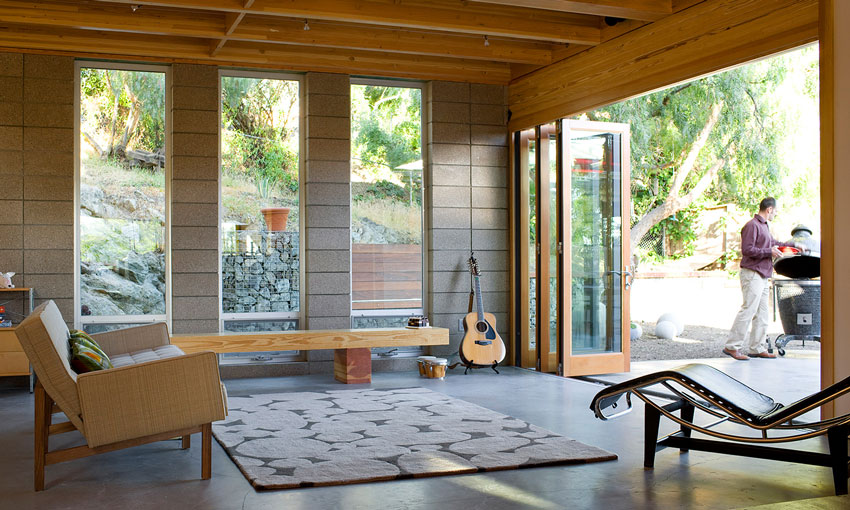
Photo courtesy of LaCantina Doors
Multi-panel door systems are more than just a focal design point—they reach beyond aesthetics to bring nature inside, and capture valuable energy and health benefits.
Multi-Panel Door Systems: A Meeting Place for Indoors and out
Multi-panel door systems defeat the barrier between a building and its surroundings, capturing the benefits of natural light and open air while enhancing the health and helping maintain the performance of a structure. When manufactured using sustainable materials and efficiency, multi-panel systems are friendly not just to creative design, but also to green demands. By mindfully considering application, operation, materials, and components, and by evaluating a manufacturer’s credentials and pride of work, a multi-panel system can be secured that is not only a best fit, but also a durable, sustainable showpiece.
 |
LaCantina Doors |

